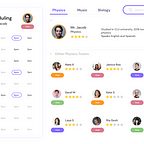What if DiCaprio had the right tech to navigate his dreams in Inception? A UX experiment!
To all those movie buffs out there in this marvellous field of design,
I bet this isn’t the first time you have tried to come up with a design solution to dismantile the main conflict in a movie plot. After all, as designers, our job is to simplify people’s lives. And one such movie that was full of complications and had an extremely convoluted plot was Inception. I mean, if you havent watched it yet, what are you really doing with your life man?
So, before I dive into this experimental concept, lets refresh on some main pointers from the movie for some context. Our protragonist here, is Cobb, played by Leonardo DiCaprio, and he enters other people’s (the target’s) dreams to steal data. This will be like our primary user.
And the remaining charecters could be seen as the other stakeholders that come into play.
Extractors/Inceptors — Extracts target’s secrets through their dreams.
Architect — one who is responsible for creating the world
Forger — Is specialised at observing people from the reality and impersonating them in a dream.
Chemist — sedates the individuals who are part of the dream-sharing, monitors biometrics
Target — Person pursued by the Inceptor.
Phase 1: Brainstroming
Rewatching the movie was a good idea. Because, here, the goal was to create a UX interface solution to the problems faced by Cobb once he enters the dream state…communication, navagation, time, the everchanging geography, and target details.
User Flow:
Cob sits on chair
Arthur opens the case-The PASIV* (Portable Automated Somnacin IntraVenous device).
Sedation is administered by the chemist
Cobb, Architect sedated
They enter the Dream
They get out either by disturbing their sleeping body in reality through sudden jolts, or by getting themselves killed in the dream.
*According to WB, the machine’s “Lithium-iodide” batteries provides up to 200 hours of power. A “LED display with atomized timer” provides the operator with continuous system updates. Numerous IV lines allow multiple users to essentially network their respective dream states, with one person acting as a conduit for everyone to hallucinate around.
The Setting :anywhere. literally anywhere, any situation
himalaya to syria
Product: Portable sedative, mobile
Physical Environment: chair/ resting space, stable ground for sedative to be placed, one bystander preferred.
So after some further understanding, we knew that we wanted Cobb to be able to
1.Communicate with the others in the dream
2.Know about the target’s biometrics
3.Have access to his user biometrics, and some basics on the other dream sharers
4.Be aware of dream level
5.Time limit, also according to the dream level, and other parametrics involved.
6.Target location
7.An interactive realtime 3D map.
Yes. you read the last one right. Because this is a concept, we went a little scifi on this one, just to push ourselves and push to see the virtual limits of UX screensolutions.
Side By Side, we even came up with a moodboard for our design. As we realised that a Dashboard would be an optimal solution, we started getting inspiration form gaming platforms and such.
The vertical line compositions were a very interesting trend that I stumbled upon while looking for colourscheme inspo. Each vertical stroke is actually the average of all the colours on a screen during a single frame. And the whole composition is the aglamation of all the frames of the movie. And below is the one for inception.
The Final concept and solution
The concept is to give Cobb a much easier and safer experience while navigating in the dream dimensions.
We incorporated an interface between the dream and Cobb to give him statistics of him and the target along with positioning system of the dynamic architecture around. User can also change their location and locate target in the area.
An interactive dashboard which is a holographic 2d screen pop-up from the Totem.
The totem, when spun, projects the holographic user interface onto the air. Cobb, interacts with the interface to know statistics or perform actions. The interface stays up as long as the totem is spinning, and when Cobb grabs the top again, the interface closed until next spin.
Figma Files
Nandini Syju
Rishiraj Ghosh
Vishal Yagyasaini
Niranjan Bala
National Institute of Design
ID’19
Course- Interaction Design
